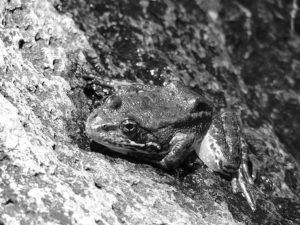
By Chip Ashley
As citizens interested in the Carmelita Mine Project cleared the Fresno County Board of Supervisors (BOS) meeting chamber on July 9, they were replaced by another, somewhat more raucous group. BOS Chair Henry Perea tried to appear unperturbed as he welcomed the group of perhaps 30 from Defend Rural America (DRA).
It was 11:50 a.m., and the agenda was already pushing lunchtime, but the apparently cowed BOS raised no objections to making a late, out-of-order addition to the agenda to allow Defend Rural America members to make a presentation that turned out to take more than 30 minutes.

I was somewhat familiar with the DRA because of a town hall meeting in the eastern Fresno County foothill community of Prather on June 19. (See a video of this meeting at http://tinyurl.com/n6h6n7u.) I had to miss the meeting, but I got reports from colleagues who had attended and raised concerns that this group would get involved in planning projects for California’s national forests and try to get those projects off track.
Approximately 700 attended the Prather meeting—a large turnout just about anywhere, but especially significant in a small rural community like Prather. Fresno County Sheriff Margaret Mims and KMJ radio host Ray Appleton spoke at the event, and Supervisor Phil Larson attended. Interestingly, Supervisor Debbie Poochigian, whose district contains Prather, did not attend.
The DRA was founded by Kirk MacKenzie in 2011 as an offshoot of the Tea Party. Ron Arteno, leader of the Central Valley Tea Party, spoke at the beginning of the Prather meeting. MacKenzie also figures prominently on the Central Valley Tea Party’s Web site.
According to the DRA’s professionally managed Web site, “Defend Rural America is a national movement to bring focus and resources to bear on the onslaught that will, if successful, diminish our nation’s prosperity, sovereignty, and security.” The “onslaught” is the environmental movement, which both MacKenzie and the Tea Party use as a bugbear to play on the fears and prejudices of low-information rural conservatives.
MacKenzie has organized meetings up and down the Sierra Nevada and the Central Valley in rural communities from Siskiyou County to Stanislaus County to Madera and Mariposa counties, with the apparent goal of using the DRA’s large membership to leverage local governments and motivate conservative voting.
At the BOS meeting on July 9, the group made a series of presentations focused on two resolutions it wants the BOS to act on. One of these would have the county usurp authority over roads and rights of way in the portion of the Sierra National Forest (SNF) in Fresno County—approximately a million acres of federal land presently administered by the U.S. Forest Service, a subdivision of the U.S. Department of Agriculture. The other would have the county usurp control over forest planning in the SNF so as to greatly expand logging, ostensibly to reduce the threat of wildfire.
In essence, these demands would require the county to get into a serious confrontation with the federal government. Although those who presented these resolutions seem to take them at face value, it is clear that the county cannot act on these resolutions as they are currently written. To do so would require nothing less than secession from the United States. So what will the BOS do? Likely, it will appease the DRA by passing watered-down resolutions without substance.
The motivation behind the first resolution is the fear that 2,000,000 acres of national forests in California will be closed to all human use due to the imminent listing of the Sierra yellow-legged frog (Rana muscosa) and the Yosemite toad (Bufo canorus) as endangered species. The claim is greatly overstated. Yes, these amphibians are likely to be listed. But, no, the listing is not likely to close 2,000,000 acres to human use.
As a participant in ongoing planning efforts for local national forests, I can assure you that there may be some closures to create buffer zones to protect these creatures’ habitat, but these will be nowhere near 2,000,000 acres and more likely will be in the low thousands or even hundreds of acres over the entire SNF. Moreover, these will likely be closures to some human uses, not all.
It was clear that the BOS saw the resolutions as more an effort to manipulate them than a serious effort to change policy. Supervisor Larson—ever the politician—took advantage of the moment for some political grandstanding. “I don’t know what value a yellow-legged frog or Yosemite toad has against human life,” he said.
The second resolution to open up logging, like the first, contained some truth. Yes, national forests in California are overgrown with small trees competing with larger trees for water and nutrients. The reason is lack of natural fire, which is a threat to mountain residents.
Most of the forest in the SNF saw natural fire every three to five years. Because of the composition of this forest before transplants of European descent started to “protect” it and suppress fire, fires were mostly low-severity fires that removed accumulating deadfall and killed most small trees and shrubs, keeping fuel loads low and returning nutrients like phosphorus, potassium and magnesium to the soil. Flashes of high-severity fire occurred now and then in areas that had missed a few fire cycles and had accumulated heavier fuel loads.
Some high-severity fire was (and still is) an important part of the natural fire-adapted forest. Patches of high-severity, stand-replacing fire opened up parts of the forest for early successional flora such as grasses, lupine and other wild flowers, and shrubs like ceanothus and manzanita that many forest fauna depend on for cover and food.
Naturally evolving forests contain tree stands of varying ages, interspersed with early successional (early seral) conditions. Natural forests are “patchy,” containing open, grassy and brushy areas, as well as dense stands of old growth timber.
Local forests add one or two tons of vegetative growth per acre annually, of which less than 10% is currently harvested. Dead limbs and trees constantly fall and accumulate. Consequently, local forests are becoming piles of kindling increasingly prone to uncharacteristic high-severity fire that now can incinerate thousands and even tens of thousands of acres, oxidizing nearly all of the biomass and displacing and killing the fauna that use these forests as habitat.
Such fires occurred only rarely before modern humans began to suppress forest fires—only every few hundred years when just the right (or wrong) conditions coincided; now such events are common. So harvest is both possible and necessary, but it must be part of careful planning.
It is good to see residents concerned about conditions in our local mountains, including catastrophic fire, but these folks from the DRA are apparently unaware of ongoing planning efforts that address their issues. The Forest Service has learned from mistakes and now has a planning scheme in place based on three core principles: collaboration, adaptive management and the triple bottom line.
In collaborative planning, the public participates with Forest Service personnel and scientists from our best universities and nonprofits. Adaptive management is based on the idea that policies have to evolve as knowledge of forests grows. Sixty years of watching and learning about local forests has taught me that forests are infinitely complex systems; we will never understand everything about them. So it makes sense to allow management policies to change as our knowledge grows. For example, we know that local forests are fire-adapted; fire is as much a natural element of forests as the trees and the creatures that live in them.
The triple bottom line involves three interrelated components: the environment, society and the economy. This means that people are important too, and we have to find a way for our mountain communities to thrive economically and socially within the forest and mountain environment.
Some of the DRA leaders know of these planning efforts. Why are they not informing the membership?
Since the late sixties, commercial interests have been in a polarized struggle with environmentalists, and the commercial interests and their proxies, including the DRA, do not get all the blame for this antagonism. Some environmental regulation did kill jobs and businesses, particularly small businesses. The large corporate interests—Sierra Pacific Industries, for example—survived and continue to flourish and clear-cut on vast areas of private land in the central and northern Sierra. Little clear-cutting occurs in the SNF, which contains little private property within its boundaries.
Although killing many jobs, regulation also protected endangered species, such as the spotted owl and the Pacific fisher, which might have gone extinct without laws such as the Endangered Species Act. Admittedly, some of this regulation was based on fallacy and science that had not received adequate peer review. Unfortunately, because of such law and regulation, for decades one could not sneeze in the nation’s forest without being sued. One result is a forest that has grown loaded with dead and dying trees—some areas with as much as 50–60 ton per acre fuel loads that only need a spark and the right weather to cause a fire that is 30%–60% high severity, rather than the desirable 10%–15%.
The good news is that commercial and environmental interests are beginning to learn how to talk with each other again and focus on common ground. Many environmentalists now realize that suing anyone whose hands look as if they might once have held a chainsaw is not working and the nation’s forests and rural communities are suffering. Planning efforts involving a collaboration of environmental and commercial interests are under way, and ways are being sought to harvest sustainably some of the prolific growth that occurs in local forests and put our impoverished rural communities back to work.
The triple bottom line is cause for hope that we can get past the antagonism of the past several decades, during which those who utilized forest resources were pitted against environmentalists who aimed to protect forests. The old paradigm of confrontation and antagonism is being replaced by a new paradigm of cooperation and collaboration. Both forests and communities will benefit.
*****
Chip Ashley is a local environmental activist and member of the Tehipite Chapter of the Sierra Club. Contact him at 559-855-6376 or wattsvalleypreservation@gmail.com.
